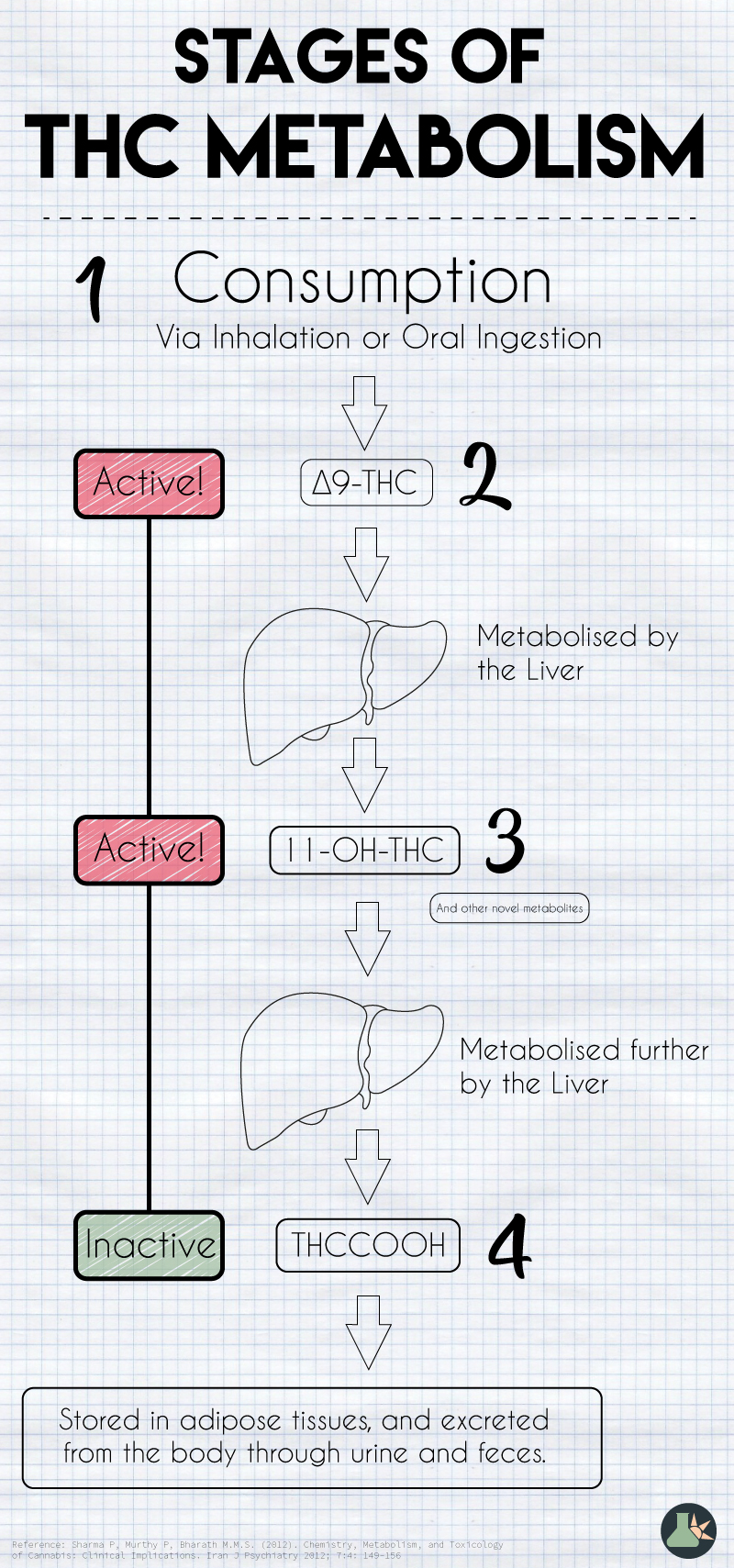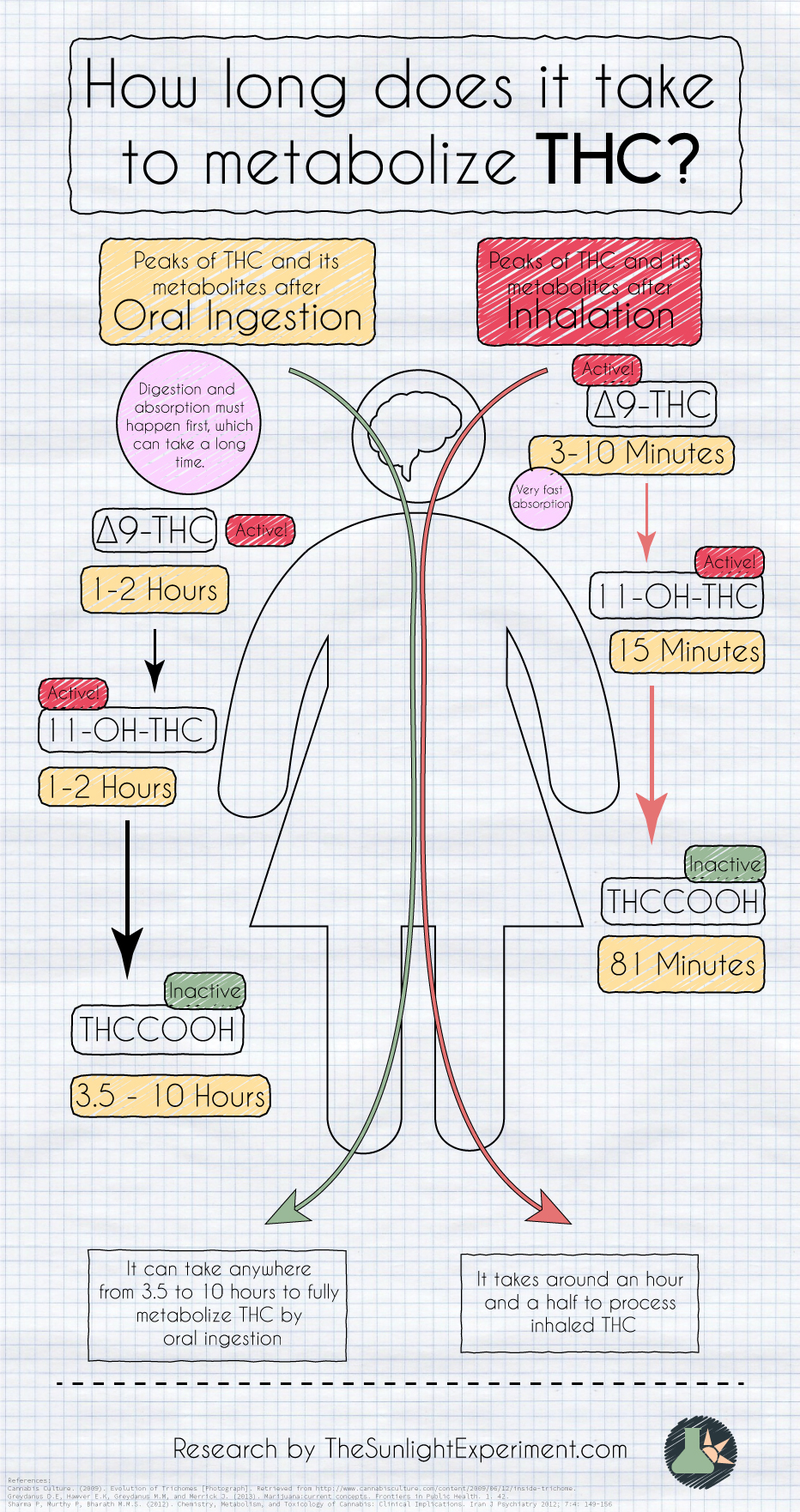The cannabis plant contains a slurry of over 421 chemicals [6] — each of which has its own unique effect on the body.
The leaves and seeds are a rich source of nutrition due to the high concentration of carbohydrates, fiber, protein, lipids, vitamins & minerals — while the flowers are more commonly used for medicinal applications.
Arguably the most important constituents in the cannabis plant are the cannabinoids — of which there are about 66 [7].
THC is the main psychoactive cannabinoid found in the Cannabis genus, while CBD is the primary non-psychoactive compound.
In this article, we’re going to cover what happens to cannabinoids like THC after it enters the body. We’ll cover how it’s absorbed, broken down, and excreted from the body as it wears off.
We’ll also go over how this process is different if you smoke THC compared to eating it, and discuss how long THC will remain in the system for each one.
Let’s get started.
A close up of the THC containing trichomes on the bud (flower) of a cannabis plant. (Cannabis Culture, 2009)
What is a Cannabinoid?
In every one of us, there exists what is called the “endocannabinoid” system. Endo (relating to endogenous) means “within”, so this really just means the “cannabinoid system within”. It’s a natural part of our anatomy involved in a huge number of important bodily functions.
When we consume exogenous-cannabinoids (cannabinoids from outside the body) such as from the cannabis plant, these chemicals interact with the system to cause changes in the body.
The endocannabinoid system is involved with the following processes:
Temperature control
Emotion and mood
The sleep cycle
Inflammation
Pain transmission
Reproduction and libido
There Are Two Kinds of Endocannabinoid Receptors
Cannabinoid receptors (CB) can be found throughout the body — there are two main types:
CB1 receptors are mainly found in the brain where it interacts with various neurotransmitters to control appetite, pain-sensation, mood, and memory.
CB2 receptors, on the other hand, is found in the peripheral tissues (outside the brain) such as the spleen and offers immune system support [4].
How are Cannabinoids Metabolized?
Cannabinoids generally enter the body in two ways:
Inhalation — where absorption occurs in the lungs.
Orally — where the absorption occurs in the small intestine.
Cannabinoids can also be injected or used as an enema (rectally) — but these routes are much less common and rarely necessary.
Depending on where these compounds are absorbed is what determines the process it needs to go through to be used and excreted from the body. Both methods will ultimately rely on metabolism within the liver.
The First Stage of the Breakdown of THC Starts Outside the Body — Decarboxylation
The phytocannabinoid acid (phyto- refers to plant sourced) (Δ9-THC-Acid) is the inactive form found in the fresh plant. Once burned it becomes “decarboxylated” and forms the active Δ9 THC. In this process, the acid group is broken off to form Δ9 THC.
This can also be achieved by heating the plant in other ways such as baking.
The Metabolite That Makes us High is Called 11-OH-THC
This Δ9 THC molecule is responsible for many of the psychoactive effects. It’s then metabolized into the active form 11-OH-THC (11-hydroxy-Δ9-THC), which mimics the effects of Δ9 THC in the body and has very similar effects on the brain.
Further breakdown then occurs to produce THCCOOH (11-nor-9-carboxy-Δ9-tetrahydrocannabinol) which is considered the inactive metabolite. [6].
Stages of THC Metabolism [Illustrated]
It should be noted that there are other metabolites produced as well, but in much less amounts.
THC Metabolism: Inhalation vs. Oral Consumption
Have you ever noticed that the effects of marijuana is different if we inhale it compared to taking it orally?
There’s a perfectly good explanation for this when we look at how each method is metabolized inside the body.
1. Inhalation of THC:
During pyrolysis (smoking), over 2000 chemicals are produced as the constituents are basically ripped apart and oxidized [6].
Δ9-THC is absorbed very quickly in the lungs and reaches a high concentration in the blood almost immediately.
It’s then spread throughout the body through the blood plasma (90%). Δ9-THC is detectable in the blood within seconds after inhalation, and peaks within 3-10 minutes. The breakdown of the constituents are as follows:
2. Oral Ingestion of THC:
Oral consumption of activated (decarboxylated) Δ9-THC is much slower than inhalation.
The decarboxylated Δ9-THC must first travel through the digestive system, where it is then absorbed through the small intestine (likely into the lymph), from there it travels up the lymph and is deposited at the thoracic duct into the bloodstream where it goes to the liver to be processed.
This means it has more steps, and on top of that, each step takes longer. Making the effects come on much slower but at a more steady pace.
Δ9-THC is then converted to 11-OH-THC very quickly (much faster than by the inhalation route). It is found in higher concentrations from oral ingestion than from inhalation [6] .
As the THC is deposited into the blood it tends to penetrate into fat tissues (such as the brain which is roughly 60% fat) [2], and adipose tissues (fat storage) throughout the body which reduces the concentration of THC in our blood. Over time, this THC is redistributed into the blood as levels drop.
Due to the fact that our fat absorbs THC when we have high amounts of it in our blood, and lets it go when we have less, THC can be seen in our bodies for a long time after the effects have worn off.
THC is Stored in Our Fat Cells Long-Term
Here’s a diagram showing the diffusion of THC into our fat cells when blood concentrations are high, only to be diffused back into the blood when concentrations are low again.
The Liver & THC Metabolism
The liver converts Δ9-THC into its metabolites (11-OH-THC, and THCCOOH) through the same enzymes that process alcohol (cytochrome P450 (CYP) complex). [6].
Excretion & Elimination of THC
Roughly 65% of cannabis metabolites are excreted fecally, and the rest through urine. 11-OH-THC is the predominant form in feces, and THCCOOH is found in higher concentration in urine [6].
How Long Does it Take to Metabolize THC?
THC metabolism goes through the same steps whether ingested or inhaled, but the duration and speed of delivery can vary greatly.
By inhaling THC, the effects are felt almost immediately, where it is then broken down into the second metabolite over the course of 15 minutes. The secondary metabolite is still highly active, and is broken down over the next few hours to the third and inactive metabolite THCCOOH (which peaks at 81 minutes after inhalation). From here the THCCOOH is excreted out of the body.
With oral ingestion, the effects are felt much later, (up to 1.5 hours), and can last several hours, but have a much steadier intensity and duration of effects. There are a lot more factors in determining the length of effects with oral ingestion due to the extra steps involved with digestion, and individual differences in liver metabolism, and digestion. Even still, the breakdown follows the same process once reaching blood circulation, and ultimately the liver.
Recent Blog Posts
References:
Cannabis Culture. (2009). Evolution of Trichomes [Photograph]. Retrieved from http://www.cannabisculture.com/content/2009/06/12/inside-trichome
Chang C.Y, Ke D.S, and Chen J.Y. (2009). Essential fatty acids and Human Brain. 18(4):231-41.
Gertsch, J., Pertwee, R. G., & Di Marzo, V. (2010). Phytocannabinoids beyond the Cannabis plant - do they exist? British Journal of Pharmacology, 160(3), 523-529. doi:10.1111/j.1476-5381.2010.00745.x
Greydanus D.E, Hawver E.K, Greydanus M.M, and Merrick J. (2013). Marijuana:current concepts. Frontiers in Public Health. 1. 42.
Russo E. (2011). Taming THC: potential cannabis synergy and phytocannabinoid-terpenoid entourage effects. British Journal of Pharmacology. 163. 1344-1364.
Sharma P, Murthy P, Bharath M.M.S. (2012). Chemistry, Metabolism, and Toxicology of Cannabis: Clinical Implications. Iran J Psychiatry 2012; 7:4: 149-156
Aizpurua-Olaizola, O., Soydaner, U., Öztürk, E., Schibano, D., Simsir, Y., Navarro, P., ... & Usobiaga, A. (2016). Evolution of the cannabinoid and terpene content during the growth of Cannabis sativa plants from different chemotypes. Journal of natural products, 79(2), 324-331.
















As COVID-19 continues to spread around the world, we’re getting a lot of questions on what the potential role of herbal medicine is during the outbreak. Learn how the virus works and how to limit your chances of transmission.